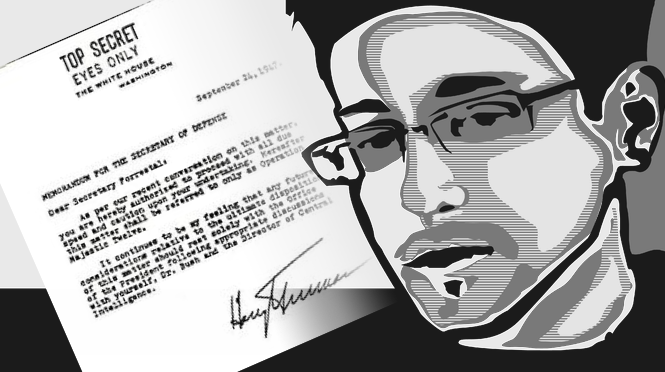It has been supposed for some time now that, if there were indeed a coverup of UFO information being perpetrated by the governments of the western superpowers, perhaps documents released by whistleblower Edward Snowden might be able to provide a few clues–if not the final word–on this contentious subject. However, after several months of combing through the documents, most journalists had likely begun to think that any serious hope for mention of UFOs therein was unlikely at best, amidst the myriad reports that highlight spies and snooping being carried out by U.S. officialdom.
Then, just last week, news of UFO images actually did turn up in one of the Snowden documents, which soon began making rounds in the blogsphere.
In the wake of such news, many would expect profound “I told you so!” moments to abound amidst the hopeful zealots who champion the loosely-contained movement promoting government “disclosure” of the UFO reality. At its best, the chief activists within the disclosure camp, such as UFO lobbyist Stephen Bassett, do manage to raise public awareness of the serious elements underlying UFO study. However, in other instances, the “movement” is one that seems both directionless, and at times even a bit misguided. With its adherence to belief in a conspiracy to hide facts from the public, based on what is already questionable data pertaining to alleged crash retrievals and secret meetings between U.S. presidents and alien beings, previous attempts at lobbying for awareness of the UFO issue by government agencies have been largely unsuccessful. At the end of the day, the conspiracies, urban legends, and the modicum of hard facts that support the basis for the existence of intelligently controlled, technologically exotic aircraft in our skies do little to promote acceptance of an underlying UFO reality that, in likelihood, does exist… whether or not it is all that it’s cracked up to be.
So rather than joyful cries of, “see, there it is! Who’s laughing now?”, the predominant attitude toward the images and scant documentation on UFOs that turned up in a few of Snowden’s leaked documents has been one of confusion. Nonetheless, there already appears to have been some meaningful commentary offered as researchers have sought to interpret just what the UFO-related material means, if anything.
Appearing within a British intelligence agency GCHQ Powerpoint presentation called, “The Art of Deception: Training for a New Generation of Online Covert Operations“, a set of fifty slides are featured, three of them bearing pictures of ‘UFOs’. Alejandro Rojas of Open Minds notes that, “The pictures include a UFO photograph from Redbud, Illinois taken in 1950, a screenshot of a UFO video captured by Arturo Robles Gil in Mexico, and a picture of an alleged UFO that is suspected to simply be a bird and its droppings.”
Greg Taylor of The Daily Grail also suggests that the reason for the inclusion of the photos, which bear no explanatory text, might have appeared in the presentation in relation to “people’s belief systems, through to them possibly being part of actual psychological operations (psy-ops),” noting further that the portion of the Powerpoint where the images appear falls under the section titled, “Influence and Information Operations”.
Both Rojas and Taylor cite an article written by Glenn Greenwald that appeared at The Intercept, a site devoted to following information on Snowden’s documents. In it, Greenwald discusses what he feels to be a consistent theme of intentional misinformation, misdirection, and psy-ops style steering of the population:
“I want to focus and elaborate on the overarching point revealed by all of these documents: namely, that these agencies are attempting to control, infiltrate, manipulate, and warp online discourse, and in doing so, are compromising the integrity of the internet itself.
Among the core self-identified purposes of JTRIG (the GCHQ’s Joint Threat Research Intelligence Group) are two tactics: (1) to inject all sorts of false material onto the internet in order to destroy the reputation of its targets; and (2) to use social sciences and other techniques to manipulate online discourse and activism to generate outcomes it considers desirable. To see how extremist these programs are, just consider the tactics they boast of using to achieve those ends: “false flag operations” (posting material to the internet and falsely attributing it to someone else), fake victim blog posts (pretending to be a victim of the individual whose reputation they want to destroy), and posting “negative information” on various forums.”
Taking Greenwald’s assertions into consideration, the discussion of the disclosure movement comes into question again, though less for any probability that may favor its likelihood, and more in relation to whether the U.S. and other governments are withholding information or lying about information it has. In terms of whether or not the populace is given access to the full extent of knowledge maintained by governments, there is simply no question; Snowden’s leaked documents show more lucidly than ever that information is withheld, and at times even controlled or purposely misrepresented by government agencies. But in relation to the idea that part of what these government agencies are misrepresenting or controlling is hidden evidence of a UFO reality, is there another, perhaps more likely role that UFOs could play in the discussion of government secrecy?
Psychological warfare is undeniably a useful tool when it comes to controlling the enemy mind, or virtually any party whose misperception of events might be useful to the individual or group initiating the control. One way that UFOs might be interpreted within this context would be to view them as a powerful tool for use in psy-ops of any number of varieties.
Going all the way back the the end of World War II, reports of Foo Fighters and, a bit later, flying saucers over the Americas had begun to elicit speculation that some secret technology, perhaps recovered from highly-classified Nazi wartime aeronautics projects, could have been at the root of the sudden arrival of UFOs. While speculation regarding an extraterrestrial presence became far more popular in the years since the end of the war, many conspiracy theories have persisted that involve the secret Nazi UFO technologies that were in development. And there are some surprisingly credible instances where the subject was discussed around that time by major mainstream news agencies.
For instance, a “flying saucer marked with the Iron Cross of the German military” was reportedly seen flying low over the Thames river in 1944. This story, reported following the war, was covered by no less venerable a source than the New York Times, who described the “mysterious flying disc” and included images purporting to show an exotic aircraft traveling over London. More recently, the British Daily Mail also covered various speculative theories shared by proponents of the Nazi UFO connection.
What does all this have to do with psy-ops, then? Quite simply, there are problems with the literal interpretation of the UFO element in relation to cases like the one reported by the Times so many decades ago. What we know of the Nazi wartime operations as the end of the conflict drew near is that their material resources were steadfastly dwindling, to the point that some of their aircraft were having to include wooden substitutes for portions of the frame where there simply was not enough metal available for use. While there are certainly a number of things the Nazis had likely been doing (which included the enrichment of uranium for a nuclear program, evidence for which has turned up in a Dutch scrap yard, as well as an underground salt mine), there is no credible evidence that they were building flying saucers, and thus rendering certain information about advanced aviation projects available to the Allies and the Russians following the war.
Interestingly, as has been pointed out by alternative historian Joseph Farrell and a few others, these reports of alleged flying saucers appearing in 1944 bearing Nazi insignias didn’t begin to emerge until well after the conflict in pieces like the New York Times article. But consider for a moment that, rather than being a true account of a flying saucer seen over London, this story might represent something else. What if, in the wake of reports of flying saucers the likes of which were reported by Kenneth Arnold and others, a desire to convey to international media agencies that the Nazis could have been behind this technology had been underway? If so, for what purpose? Quite simply, the implication would have been that any such technology produced by Germany during the war was likely now to be in the hands of either the Allied powers, or of Russia. Even if neither party possessed such wild capabilities, Russians who read such reports in the media, and given serious treatment by respected American news agencies, would have likely viewed the entire flying saucer craze as evidence of new, highly advanced aircraft the Americans were building, not of aliens visiting planet Earth. And through their bluffs, members of the American intelligence community could have given the impression abroad that the western powers were wielding much larger sticks than they really were carrying.
While none of this removes the potential reality of UFOs from the bigger question, it does highlight one of many ways misinformation about UFOs could be used to convince our enemies that whatever weapons we are in control of possess far more potentially destructive power than anything they would have. As John F. Kennedy had argued, peace could best be maintained by a world power whose military was well-armed enough to deter conflict, rather than to provoke or invite it through its weaknesses. And thus, by fooling people into thinking UFOs belonged to U.S. powers, one might argue we were able to misrepresent ourselves as possessing the most advanced and powerful weapons of any nation (though in truth, history shows that the United States already did). Whether such bogus information had been released through the New York Times, or as we would see later, through secret hand-offs to honest-intended UFO researchers whose confirmation biases would lead them to buy what later would be proven to be poorly-executed misdirection (Majestic 12, anyone?) would be of little consequence.
With the latest batch of Snowden documents, consider again the context in which UFO images appear in this Powerpoint presentation that’s gotten everyone talking. There may not be text with the images, but the title of the presentation in which they appear, again, is The Art of Deception: Training for a New Generation of Online Covert Operations. The internet sure makes handy, and more accessible, what mainstream news agencies like The Times may have had to be used for decades ago.
While many were waiting for UFOs to show up in Snowden’s documents (a wish that had been similarly fitted to Julian Assange’s leaked documents and activities with Wikileaks a few years back), what has shown up instead is appropriately confusing… many commentators on the subject are looking at these images, and straining their minds to deduce some purpose from them, when the truth of the matter may be far simpler: that these images have very little to do with UFOs at all, and everything to do with the use of information disseminated online by parties that are interested in controlling the way that people think. Even worse, proper placement of “bad” information becomes a perfect tool for discrediting an individual, and exposing them as gullible fools so dedicated to the discovery of their own personal wonderland, that they allowed themselves to trail off down an empty hole which no rabbit had ever even gone into in the first place.
With credibility thus removed, any potential for “problem individuals” becomes lessened just as well. Why would we need MIBs, cloak-and-dagger conspiracies, and cover ups, when discrediting the beliefs of the UFO community could be achieved as simply as tossing up red herrings here and there along the way, and in particular, on websites and forums where the source of that information may not be properly questioned?
Admittedly, some would argue that we can’t justify the problems with one matter of conspiratorial thinking (government disclosure of UFO information, for instance) with another speculative line of thought which involves allegations of a similar, but non-UFO related conspiracy. While speculative, what we’ve discussed here is backed by what I feel to be a plausible interpretation of why UFO images are included within the Powerpoint presentation included with the Snowden leaks… and it’s an interpretation that has little to do with any actual UFO information at all. The likely solution is that UFOs are but one of many subjects that intelligence agencies would probably find useful for disseminating misinformation, and for any number of reasons.
On a side note, I’ve always been interested in how many researchers have been more than willing to consider the fact that fiascos like the Majestic 12 documents were exposed as a hoax, and yet much less thought seems to be put toward the reason behind the deception. In my experience, researchers involved with such debunking often don’t wish to even discuss the matter any further; once a proven fake, discussion should end, and energy redirected toward more fruitful areas of inquiry. Sure, while those who “properly debunk” should be commended for exposing bad information, the level of dismissal this attitude boasts after the fact seems a bit reminiscent of the continuous collection of UFO reports by various groups over the years, who seem to intend to do nothing with that data but keep collecting and storing it: at some point, we should probably ask why. If some UFO reports are valid, what do they represent, and why are they here? What can we really learn from what evidence we have?
Much the same, if misinformation and hoaxes turn up, and seem to be at least tangentially related to government operations or agencies, this potentially opens a whole new line of inquiry; but unfortunately, the attitude among many in this field is quite the opposite. Indeed, it seems that the proverbial “nothing to see here, move along” mindset can manifest in the most unlikely of places.
The UFO enigma is rife with complexities. But at times, perhaps we should be more willing to ask ourselves, “how much of what we are seeking to understand actually has to do with unidentified flying objects?” If there is anything we can glean from the scant UFO references that do appear in the Snowden leaks, it’s that the mystery we perceive is probably far more complex than the simple act of looking for strange things in the sky.





”The Art of Deception: Training for a New Generation of Online Covert Operations“. . .is a sad commentary on the physiological make up of those we elect to lead us, and those whose salaries we pay to defend and protect us.
Can you,or anyone reading this, point me to any incontrovertible proof that the Majestic 12 documents were a hoax? I’m going to assume that there’s few so silly as to believe that the FBI and the USAF declaring them fake means anything.
@pov: First, no, I cannot provide such incontrovertible proof.
But, consider this: (I am going by my recollection of a summary provided by Jerome Clarke many years ago in FATE magazine). Go through each of the claimed information in them. What is new in them? Nothing. Really, EVERY piece of “information” can be found in prior UFO and UFO-related literature. I concluded that it’s a rehash; somebody picked out ideas and was feeding them back to the UFO researchers.
So I challenge YOU: Show us where the MJ12 documents provide information that is certainly fresh and new.
Carl Sagan himself has pointed out that the Pentagon is the last outfit on Earth who would want US citizens and the world to know that Russian MIGs have penetrated American airspace all the way to the headwaters of the Mississippi, or that experimental craft of the American military are skulking about. I might add that they would consider even less palatable word getting out that advanced craft (perhaps alien) actually operate freely over said airspace. You have made an excellent point, also made by Jacques Vallee, that the entire subject of UFO research is contaminated with disinformation.
To pretend that US intelligence services are the world grand masters at disinformation would be like pretending that only the US produces the finest chess players. I happen to think there may be truth to the claim made by Tea Party flakes that FOX news is owned by the Chinese intelligence service. Any aliens cooperating with governmental agencies (which they must be doing if they are actually traipsing about) are surely not to be trusted. After all of the disinformation disseminated over the past 65 years, I would not trust any alien any further than I could levitate the Pentagon.
I think your point about the UFOs depicted in the PowerPoint presentation is quite damning. Someone (perhaps many) wants us to continue wandering in the wilderness (Why the ancient Hebrews would continue to follow such a pillar of lies is utterly bewildering, considering the advanced astronomical knowledge of the ancient Egyptians, and their alleged heretic prince, Moses). We cannot believe anything solely based on authority. You, on the other hand, have made a most trenchant point.
I have taken another, closer look at that British Intelligence slide presentation, allegedly for purposes of training a new generation of disinformation artists. For one thing, there is no accompanying text. Whoever made this presentation must have gotten all of his lecture notes from a separate source. Never mind that. The entire presentation looks to me exactly like training material. Overall, it is so astonishing and crucial that I think each of the 60 slides deserves comment, so I am posting my running commentary at my website. Stay tuned.